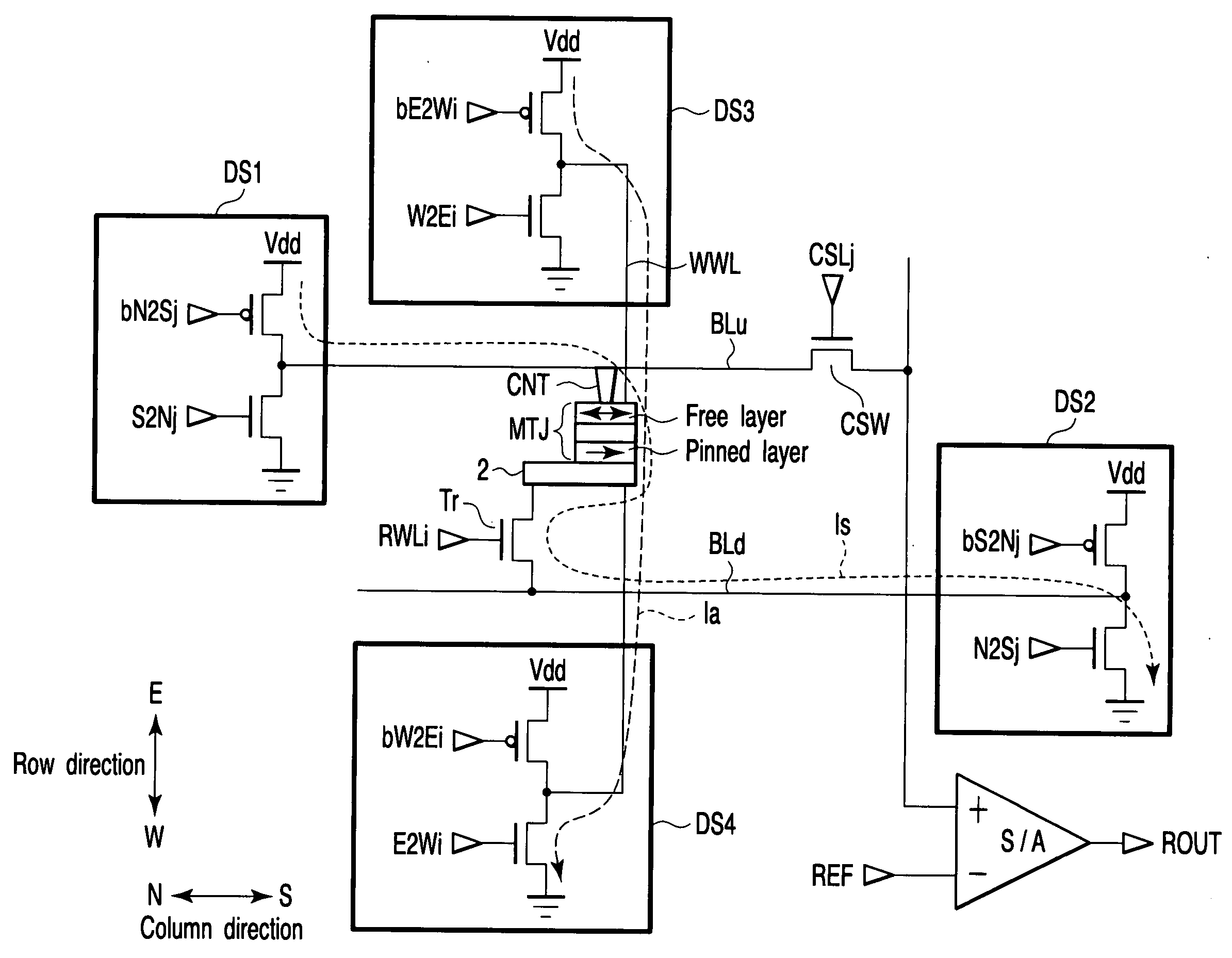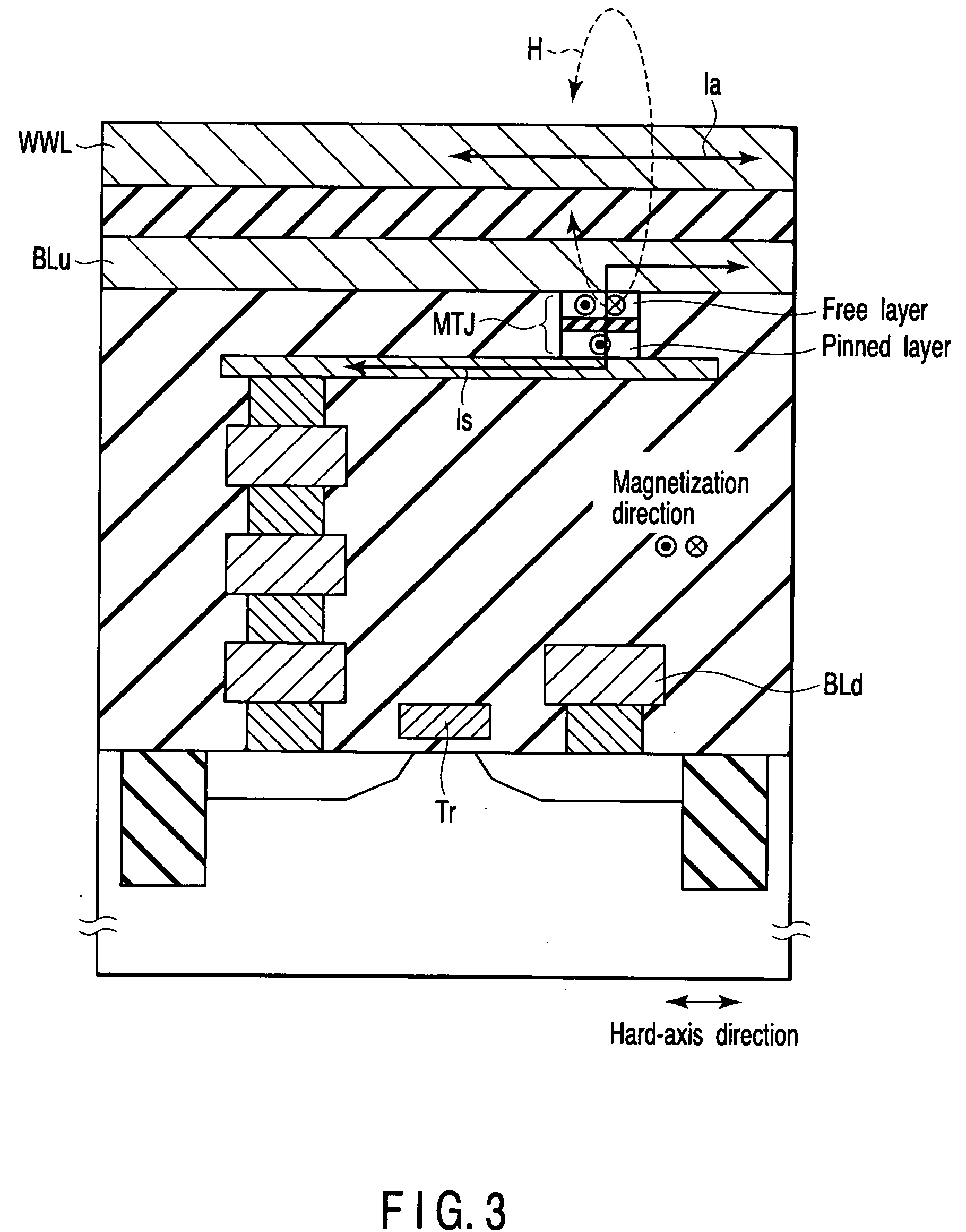Spin-injection magnetic random access memory
a magnetic random access and magnetic technology, applied in the direction of digital storage, instruments, semiconductor devices, etc., can solve the problems of large memory capacity, inability to reduce pulse current to the value required, and increase electric power consumption
- Summary
- Abstract
- Description
- Claims
- Application Information
AI Technical Summary
Benefits of technology
Problems solved by technology
Method used
Image
Examples
first embodiment
(i) First Embodiment
[0111]FIG. 11 shows a first embodiment of the magnetoresistive element.
[0112] In the first embodiment, the magnetoresistive element includes an anti-ferromagnetic layer 3, a first magnetic fixed layer 4, a tunnel barrier layer 5, a magnetic recording layer 6, a non-magnetic metal layer 7, a second magnetic fixed layer 8, and an anti-ferromagnetic layer 9. The magnetic recording layer 6 is arranged on the first magnetic fixed layer 4 through tunnel barrier layer 5. The second magnetic fixed layer 8 is arranged on the magnetic recording layer 6 through the non-magnetic metal layer 7.
[0113] In the first magnetic fixed layer 4, the magnetization state is fixed by exchange interaction bonding between the first magnetic fixed layer 4 and the anti-ferromagnetic layer 3. In the second magnetic fixed layer 8, the magnetization state is fixed by the exchange interaction bonding between the second magnetic fixed layer 8 and the anti-ferromagnetic layer 9. The magnetizatio...
second embodiment
(ii) Second Embodiment
[0123]FIG. 12 shows a second embodiment of the magnetoresistive element.
[0124] The second embodiment is one of modifications of the first embodiment, and the second embodiment differs from the first embodiment in the structure of the second magnetic fixed layer.
[0125] In the second embodiment, the magnetoresistive element includes the anti-ferromagnetic layer 3, the first magnetic fixed layer 4, the tunnel barrier layer 5, the magnetic recording layer 6, the non-magnetic metal layer 7, a second magnetic fixed layer 8SAF, and the anti-ferromagnetic layer 9. The magnetic recording layer 6 is arranged on the first magnetic fixed layer 4 through tunnel barrier layer 5. The second magnetic fixed layer 8SAF and the anti-ferromagnetic layer 9 are arranged on the magnetic recording layer 6 through the non-magnetic metal layer 7.
[0126] In the first magnetic fixed layer 4, the magnetization state is fixed by the exchange interaction bonding between the first magnetic ...
third embodiment
(iii) Third Embodiment
[0138]FIG. 13 shows a third embodiment of the magnetoresistive element.
[0139] In the third embodiment, the magnetoresistive element includes the anti-ferromagnetic layer 3, the first magnetic fixed layer 4, the tunnel barrier layer 5, the magnetic recording layer 6, the non-magnetic metal layer 7, the second magnetic fixed layer 8, and the anti-ferromagnetic layer 9. The magnetic recording layer 6 is arranged on the first magnetic fixed layer 4 through tunnel barrier layer 5. The second magnetic fixed layer 8 is arranged on the magnetic recording layer 6 through the non-magnetic metal layer 7.
[0140] In the first magnetic fixed layer 4, the magnetization state is fixed by the exchange interaction bonding between the first magnetic fixed layer 4 and the anti-ferromagnetic layer 3. In the second magnetic fixed layer 8, the magnetization state is fixed by the exchange interaction bonding between the second magnetic fixed layer 8 and the anti-ferromagnetic layer 9...
PUM
 Login to View More
Login to View More Abstract
Description
Claims
Application Information
 Login to View More
Login to View More - R&D
- Intellectual Property
- Life Sciences
- Materials
- Tech Scout
- Unparalleled Data Quality
- Higher Quality Content
- 60% Fewer Hallucinations
Browse by: Latest US Patents, China's latest patents, Technical Efficacy Thesaurus, Application Domain, Technology Topic, Popular Technical Reports.
© 2025 PatSnap. All rights reserved.Legal|Privacy policy|Modern Slavery Act Transparency Statement|Sitemap|About US| Contact US: help@patsnap.com



